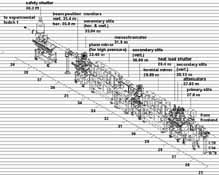ID09 Optics Hutch
New optics layout to prepare for a crygenically cooled monochromator
 important numbers for setup (443 kB)
important numbers for setup (443 kB)
General Description (of the old layout):
The first optical element in the beamline is a toroidal mirror. The toroidal shape is obtained by vertical bending of a cylinder which makes it possible to vary the defocusing factor M over the range 0.35-1.0. The mirror is coated by a 500Å layer of platinum with a surface roughness of 1.8Å rms. The longitudinal figure error of the mirror - the limiting factor for the vertical focusing - is 9.0µrad(rms) over its full 1000 mm length. The size of the focal point is a competition between spherical aberrations and mirror imperfections. The spot is smallest on table 1 at 150x150 µm2. On table two it increases to 240 µmh x 350 µmv. The focal point on table 3 is 240 µmh x 700 µmv broadened predominantly in the vertically direction due to the long lever arm to the focal spot. The heat load on the mirror is highest when the mirror is used to focus on table 1. Here the demagnification is M= 0.39 and the glancing angle 3.69 mrad. At 200 mA the mirror intercepts 1520 W of white beam power of which 980 W are absorbed. It appears that the main effect of the heatload is a vertical temperature gradient of the bender frame arising from Compton scattering from the mirror surface. The mirror is therefore now equipped with a water cooled "Compton roof".
The ID09 beamline has a water-cooled double monochromator designed to operate between 4.9-39.6 keV. The water-cooling can extract 25 W before the rocking curve starts to broaden. It is mainly used with the U20 undulator and occasionally with the U46 and W70 at low currents, i.e. single-bunch mode.
The distance between the two crystals is held fixed 10.0 mm, and that causes a vertical shift in the position of the beam with Bragg angle
-
- (Dh = 10 mm x sin2q /sinq).
In energy scans the height of the experimental table can be linked to the energy of the monochromator such that fixed-exit scans can be realised. The crystals are mounted in a holder that has a weak mechanical link that allows adjusting the angle between the crystals. The horizontal beam position is controlled at two levels: a stepper motor tilts the first crystal and a piezo tilts the second with high resolution.
The rejection of harmonics has to be considered due to the fixed energy cut-off at 38 keV of the toroidal mirror. In the range 4.5-12.7 keV, the (333) reflection contaminates the beam. The problem can be solved by opening the gap of the undulator hereby the content of hard radiation is reduced.
The U17 undulator foreseen for ID09 in 2001, will produce a total power up to 2740 W and a power density up to 110 W W/mm2. Final element analyses has shown that at these power densities, the deviation from crystal planarity becomes close to the rocking width of Si(111) even at cryogenic temperatures.
The second mirror is a 1.2 m plane mirror mounted in a meridional bender which allows great freedom in the choice of energy and defocusing range. The mirror body is a single crystal of Si coated by Pt. By analogy with the toroidal mirror the mirror is water cooled from the sides using a liquid Indium-Gallium interface. The mirror is now installed and the excellent bending properties of pure Si is expected to produce a 35 µm horizontal line focus for energies up to 60 keV.
| optical elements | mirror 1 | monochromator | mirror 2 |
| distance from source* | 29.7 m | 32.6 m | 35.8 m |
| beam size at sample | 0.15 - 0.24 mmh x 0.18 - 1.1 mmv | ||
| spectral range | 7 - 40 keV focused; 7 - 120 keV unfocused | ||
| resolution in DE/E | 2.0x10-4 at 10 keV; 6.0x10-4 at 40 keV | ||
| white flux at sample | 2.0x1013 ph/(s 0.1%bw, 0.1A 0.2x0.2 mm2) at 20 keV** | ||
| mono flux at sample | 1.0x1010 ph/(s 0.1A, 0.2x0.2 mm2) at 25 keV over 8.5 eV bandwidth** | ||
* distance from centre of straight ID straight section
** wiggler source (undulator nearly identical)





